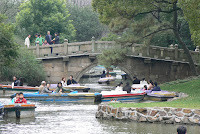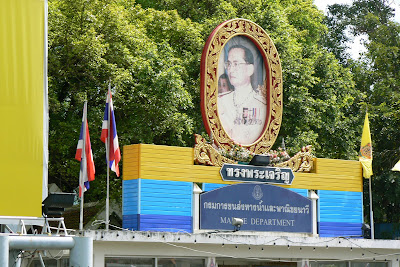I'm the one person in Asia who keeps visiting Buddhist temples and just never gets tired of it. I'll keep things to a minimum and focus on some favorite pictures. First of all, Thailand's largest temple is the Wat Pho, which contains a gold-plated, 150 foot long, reclining Buddha. It's housed inside a large wooden building, which isn't large enough to give any real perspective on the Buddha, and has a large wooden panel in the center. So it can only be seen right at its enormous head, or right at its enormous feet. Here, I took a picture at the second option.

One thing I find interesting about Buddhist temples is that they often have the same architectural and iconic conceits, but the design and usage of these conceits vary wildly between different sects and different regions. For instance the single, solitary stupa, which is at the center of traditional Buddhist temples, evolved into both the familiar pagoda, and the Thai chedi, there's a number of them scattered about:

They're decorated with layered enamel. Some other areas of the wat were similarly, whimsically decorated:

Finally, here's a shrine, from the same compound. It's all gold and crystal:

At the foot of the shrine is where the offerings are placed, although in this case it's just symbolic:

This is a wat I was very impressed by, it was also located in a fun area to wander around. It was dominated by a monumentally labyrinthine chedi.

It's hard to absorb all the details, this is a blow up of some cool demon-looking guys, standing side by side in a circle around the chedi.

Bangkok seemed a very religious city. Buddhism wasn't limited to these larger temples, which could possibly be seen as a historical relic. Just walking down the street, it was common to see people with small Buddhist artifacts. Here's a corner shrine, right in the center of a really tony shopping district:

 It was really busy due to an annual remembrance. I wish I could remember the exact story, something strange about a bank building with bad luck...anyway across the street at night, the other places that were open were large outdoor beer halls, they had really bad bands playing and seemed to be relatively popular places for young wealthy Thai kids to go. Next to the beer halls were small shrines, people walking by (including some of the partiers) would make a small offering and prayer:
It was really busy due to an annual remembrance. I wish I could remember the exact story, something strange about a bank building with bad luck...anyway across the street at night, the other places that were open were large outdoor beer halls, they had really bad bands playing and seemed to be relatively popular places for young wealthy Thai kids to go. Next to the beer halls were small shrines, people walking by (including some of the partiers) would make a small offering and prayer:
I found it interesting that even though Bangkok is thoroughly Buddhist, the Buddhism often included elements of Hinduism. Maybe it's a no-no in the more orthodox temples, but walking down the street I often came across takes on the Hindu god Ganesh:

I also came across other religion's temples, purely as a guess they were built to serve Bangkok's often long-time immigrant communities of Indians and Westerners, along those lines there were Chinese-style Buddhist temples. There were also occasional Hindu temples, mosques, and this small but large-steepled riverside Christian church:





















































